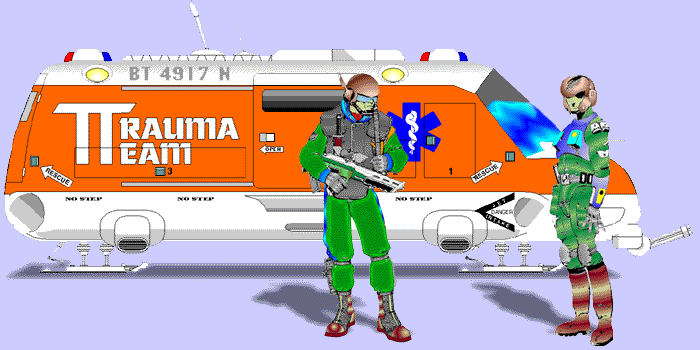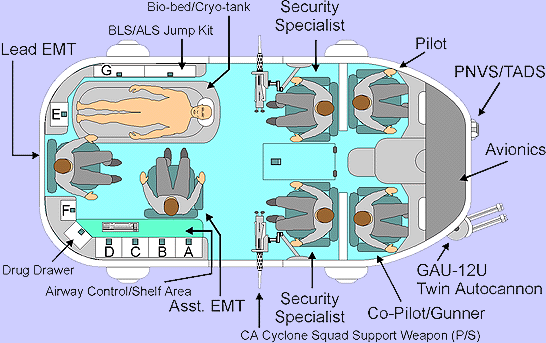

Trauma Team Int'l. AV-4A BLS/ALS Unit & Medical Personnel
Last updated 17 Oct. 1997
Designed and assembled by Mark Cook.Editted by Marc Brenowitz.
Return to "Tool Talk" page
Please take a moment to read the Copyright Notice for this material.


When a TTI Card is activated, this is the standard Trauma Team ® unit that responds.
The aerodyne is a McDonnell-Douglas model AV-4A Tactical Urban Assault Vehicle with a customized body. Powered by a single Rolls-Royce Pegasus II Vectored Thrust Turbofan, with 9,628 kgs. of thrust, it is capable of speeds up to 564 kph and has a maximum operational radius of 645 km.
Fully loaded, the AV-4A weighs 4,773 kg. This light weight is the result of extensive use of composite materials in both the chassis and the body. Also, thanks to the use of Epoxide laminate Aramides in the outer body, the AV is extremely resistant to small arms fire and light anti-vehicle weapons. (Body has an SP of 40 and an SDP of 100.) The interior of the AV-4 is divided into two sections: the cockpit (forward compartment) and the "med-bay" (aft compartment).
The cockpit is separated from the aft compartment by a reinforced bulkhead (SP=40, SDP=50) and has an isolated air filtration system. An intercom system keeps the pilot and co-pilot/gunner in contact with the rest of the crew at all times. The cockpit is accessed via a hatch into the aft compartment, or directly to the exterior via lockable doors to the port and starboard.
The aft compartment, or "med-bay" can also be sealed (if necessary), and is accessed via large sliding doors, port and starboard, in the sides of the fuselage. Both doors are equipped with explosive bolts that can be activated either from the cockpit or from the med-bay.
| Weapon | Caliber | Damage | Mag. Cap. | ROF | Rel. | Range |
|---|---|---|---|---|---|---|
| GE GAU-12U | 25mm | 8d10+4 | 2,000 | 60 | VR | 1000m |
| CA Cyclone SSW | 7.62x51mm | 6d6+2 | 250 | 35 | VR | 400m |
The TTI AV-4A is manned by a crew of six specialists, as follows:

The Trauma Team AV-4 packs a tremendous amount of life-saving equipment into an amazingly small volume. Each crew-member has an assigned position and, during transport, is seated in a McDonnell-Douglas ACES III (Advanced Concept Ejection Seat) rocket-powered, acceleration-damped, ejection seat equipped with a vectored-thrust pitch control system and a 5-point harness. It is capable of zero-zero performance, and is cleared for use up to a height of 50,000 feet and a speed of 600 knots, which far exceeds the operational envelope of the AV-4A.
The pilot and co-pilot/gunner (CPG) operate in a "glass cockpit", which boasts 5 CRT MFDs (Multi-Functional Displays) and an independent HUD (Heads-Up Display) for each crew-member. Flight controls are very similar to that of a conventional helicopter, and consist of a cyclic "joy stick" and a collective lever (to the left.) Additionally, the Litton NR760 TADS/PNVS (Target Acquisition Designation System / Pilots Night Vision System) is coupled to the helmets of both the pilot and CPG, with output visible via either neural jack or flip-down visual reticle. Additionally, the CPG's helmet is equipped with "look down, shoot down" IR position indicators, such that the weapons turret points where the CPG looks. A cross-hair image is provided for the CPG either via smartgun link (+2 to hit) or via helmet reticle (+1 to hit.) The system provides both cockpit crew-members with the equivalent of Low Light, Thermograph, and TeleOptic vision, for all views external to the AV.
The AV-4 cockpit is equipped with 3 independent 2-way radio systems: 2 Sabre 1200 FM commo suites (one for city frequencies, the other for county frequencies), and 1 Sabre 2100 FADES (Frequency-Agile, Dual Encryption Security) Tactical Communication System. The latter system is used exclusively for communicating either with the local TTI base, or with other TTI vehicles. The "med-bay" (aft compartment) is equipped with a Body Weight Med-Line 2000 voice/vision/fax/data Transceiver set. This unit is connected directly to the cryo-tank (below), which allows direct transmission of patient vitals to TTI Medical Control. It can also accept a wide variety of data disks and chips to facilitate diagnosis.
The AV is equipped with an APG-85 multi-mode, all-weather, Pulse-Doppler "smart" radar. It has an operational range of 150 km against targets with an RCS (radar cross-section) similar to the AV-4. It includes TWS (track-while-scan), NCTR (Non-Cooperative Target Recognition), and a "look down" SAR (Synthetic Aperture Radar) mode which can produce an almost photographic-quality monochrome image. This is an invaluable feature when approaching a potentially hot LZ. Further, the AV is equipped with flare and millimeter chaff dispensers, mounted to the ventral aft fuselage.
Of course, all of the other features of the TTI AV-4A exist solely to support it's primary function: the transport of sick and/or injured clients. To this end, the AV is packed with state-of-the-art emergency medical equipment and supplies.
The heart of the AV is the BodyWeight CR-2000 "Last Chance" Life Pod ® (combination bio-bed / cryo-tank.) This marvel of medical technology serves two major funtions. The "bio-bed" function provides the EMTs with a "Super Gurney" which warms, cushions, restrains, and generally protects the patient. It also has built-in bio-monitor and "smart" IV controller, as well as a Portable Intern Unit (ChromeBook 3, pg. 7) (+2 to the Diagnose skill and +1 to stablization attempts.)
When damage is too severe, the "cryo-tank" comes into play. Once the patient is placed in the tank, a BodyWeight VC-100 Vascular Shunt (AKA "Vampire Cuff") is placed around the patients neck. The shunt automatically locates the external Carotid arteries and the external Jugular veins, and inserts bypass cannulas which immediately begin circulating oxygenated heme substitute to the brain. Once the shunt is activated, multiple doses of RBA (Radicals Binding Agent or "Rhythym & Blues" as it is frequently called) are injected throughout the body to prevent free radicals from accelerating cellular breakdown. An ET tube is inserted to flush the lungs with moist, oxygenated air and sealing tape is used on the nose and mouth. The cryo-tank is then closed and flooded with aerated, electrolytically balanced suspension gel, cooled to a temperature of 24° F. The patient is thus stabilized for delivery to the nearest critical care facility.
Additional standard equipment consists of:
|
Interior Compartments (From illustration above) |
||||
| Compartment A | Compartment B | Compartment C | Compartment D | Compartment E |
| Airway Control/Shelf Area | Compartment F | Compartment G | Drug Drawer | BLS/ALS Jump Kit |
| Front cab | ||||
| Exterior Compartments | ||
| Driver's side #1 | Driver's side #2 | Driver' side #3 |
| Officer's side #1 | Officer's side #2 | Officer's side #3 |
Top
|
Middle
| Bottom |
Top
|
Bottom
|
Top
|
Bottom
|
Left
|
Right
|
| Left |
Right
|
|
|
|
|
|
|
|
|
|
|
|
Copyright © 1997, |

|
All Rights Reserved. |